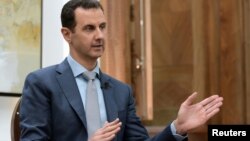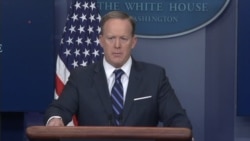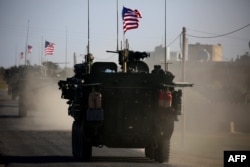The battle to oust Syrian President Bashar al-Assad appears to be over — at least as far as the Trump administration is concerned.
The U.S. ambassador to the United Nations, Nikki Haley, said Thursday that Washington’s “priority is no longer to sit and focus on getting Assad out.”
Haley’s remarks drew the ire of American lawmakers who have argued for a more robust U.S. effort to topple Assad. Republican Senator John McCain warned the Trump administration against making a "Faustian bargain" (a deal with the devil) with the Syrian government’s ally Russia.
Republican Senator Lindsey Graham warned that taking the focus off Assad would be “the biggest mistake since President [Barack] Obama failed to act after drawing a red line against Assad's use of chemical weapons."
WATCH: Spicer says future of Assad up to Syrians
Later Friday, White House spokesman Sean Spicer said that the United States must accept the political reality that the future of Assad is up to the Syrian people.
"With respect to Assad, there is a political reality that we have to accept in terms of where we are right now," he said. Spicer added that the Untied States lost "a lot of opportunity" during the last administration to change the situation with Assad. He did not elaborate.
Spicer would not comment on whether Assad should step down, saying it is a decision for the Syrian people alone. He said the foremost priority for the United States in Syria right now is the defeat of Islamic State militants.
Some Middle East analysts say similar comments by U.S. Secretary of State Rex Tillerson this week in Ankara also signal regime change is off the table. These analysts argue the recent remarks merely reflect the reality on the ground — that Assad's survival after a brutal six-year-long conflict appears assured.
Expected move
Many analysts had been expecting President Donald Trump's administration to inch closer to a much more explicit shift in U.S. policy in Syria — one exclusively focused on the war against the Islamic State. Some analysts say the administration has little alternative now. They trace the policy reversal to the Obama administration, which in its last months also was signaling an acceptance of Assad staying in power, if only in the short-term during a political transition.
In a roundtable discussion this week on the future of the conflict on Syria, analyst Sam Heller of The Century Foundation, a U.S. policy research institute, argued that not much is left of the revolutionary opposition.
“When we say that the Assad regime has ‘won the war,’ we mean it’s achieved a strategic victory in Syria’s central civil conflict: the war between, in approximate terms, the regime and its mixed revolutionary-Islamist opposition in western Syria,” he said.
According to Heller, much of the main armed opposition to Assad has been neutralized and diverted away from the insurgency against the government by regional powers who are using rebel militias for their own security projects in war-torn Syria. That includes the Turks, who have carved out a sweep of territory in northern Syria to keep Islamic State militants away from its border and block Syrian Kurds from uniting Kurdish-majority cantons.
The U.S. has persuaded other Arab Sunni and Turkmen militias to throw in their lot with the Kurdish People’s Protection Units, or YPG, and to focus on battling the Islamic State. The U.S. is generally working with splinter groups or rejects from the main anti-Assad rebel force, the Free Syrian Army (FSA).
Rebel militias not participating in the Turkish intervention or who are not aligned with the fight against the Islamic State have seen foreign backers cut their arms supplies.
Heller says the future for FSA militias is bleak.
“The choice they now seem to face is between being reincorporated into the extant Syrian state [Assad’s state], serving in a Turkish or Jordanian cross-border protectorate, or indefinite exile. Or they can die with the jihadists, which is also an option. They can and will continue to fight, but they’ll likely be doing so alone, against insurmountable odds, and at a terrible cost to their civilian families and communities.”
Tahrir al-Sham group takes lead
Most recent breakout assaults by rebel militias have been led by a former al-Qaida affiliate. It has joined with other Islamist rebel militias in a group called Tahrir al-Sham, and last week assaulted the Syrian town of Hama, managing to advance to within 10 kilometers of its center. Other insurgents also recently launched an offensive on government-held areas in the Damascus suburb of Jobar.
But there’s little prospect the Hama and Jobar offensives can be translated into major threats to the government, which was bolstered when Russia's military intervened to back Assad more than a year ago. In December, the government, backed by Iranian and Shi'ite militias, recaptured the rebel redoubt in the eastern half of Aleppo.
Since December, Syrian government forces and foreign fighters have been pressing their military edge, slowly winning back rebel-held areas near the Syrian capital and squeezing Tahrir al-Sham and other Islamist militias in the northern Syrian province of Idlib, to the west of Aleppo.
Several military observers from European governments told VOA in recent weeks that they see no way that opposition forces can threaten Assad’s hold over the main western and coastal cities of Syria.
They do expect fighting to continue, though, led by Tahrir al-Sham.
Aron Lund, an analyst with the Carnegie Endowment for International Peace, a research institute in Washington, agrees with those assessments. At The Century Foundation’s roundtable, he predicted: “There will be fighting for a long time and Syria may remain a failed state in many respects, and, of course, some unscripted event could still turn all assumptions upside down. But as things stand, Assad is definitely over some sort of threshold.”
Lund says Western and Arab governments that had sought regime change in Syria have now mostly accepted that their side has no path to victory.
"They are coming to terms with the fact that Assad is staying, while deciding to what extent they want to play spoilers. They’re not willing to say it publicly, but it’s happening,” Lund said.











